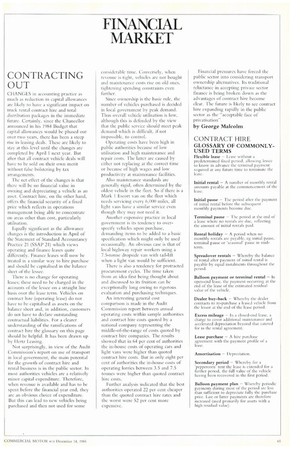CONTRACTING OUT
Page 67

If you've noticed an error in this article please click here to report it so we can fix it.
CHANGES in accounting practice as much as reduction in capital allowances are likely to have a significant impact on truck rental contract hire and total distribution packages in the immediate future. Certainly, since the Chancellor announced in his 1984 Budget that capital allowances would be phased our over two years, there has been a steep rise in leasing deals. These are likely to stay at this level until the changes are completed by April 1 next year. But after that all contract vehicle deals will have to be sold on their own merit without false bolstering by tax arrangements.
The net effect of the changes is that there will be no financial value in owning and depreciating a vehicle as an asset. Contract hire, on the other hand, offers the financial security of a fixed price which reflects in operations management being able to concentrate on areas other than cost, particularly utilisation.
Equally significant as the allowance changes is the introduction in April of the Statement of Standard Accountancy Practice 21 (SSAP 21) which views operating and finance leases quite differently. Finance leases will now be treated in a similar way to hire purchase and should be capitalised in the balance sheet of the lessee.
'Mere is no change for operating leases; these need to be charged in the accounts of the lessee on a straight line basis over the lease term. Vehicles on contract hire (operating lease) do not have to be capitalised as assets on the balance sheet and, in addition, customers do not have to declare outstanding contractual liabilities. For a clearer understanding of the ramifications of contract hire the glossary on this page should be helpful. It has been drawn up by I Iertz Leasing.
Not surprisingly, in view of the Audit Commission's report on use of transport in local government, the main potential for the growth of contract hire and rental business is in the public sector. In most authorities vehicles are a relatively minor capital expenditure. Therefore, when revenue is available and has to be spent before the financial year end, they are an obvious choice of expenditure. But this can lead to new vehicles being purchased and then not used for some considerable time. Conversely, when revenue is tight, vehicles are not bought and maintenance costs rise on old ones, tightening spending constraints even further.
Since ownership is the basic rule, the number of vehicles purchased is decided in local government by peak demand. Thus overall vehicle utilisation is low, although this is defended by the view that the public service should meet peak demand which is difficult, if not inipossible. to control.
Operating costs have been high in public authorities because of low utilisation and high maintenance and repair costs. The latter are caused by either not replacing at the correct time or because of high wages and low productivity at maintenance facilities.
Also maintenance standards are generally rigid, often determined by the oldest vehicle in the fleet. So if there is a Mark 1 Escort van on the fleet which needs servicing every 6,000 miles, all light vans have a similar service even though they may not need it.
Another expensive practice in local government is its tendency to overspecify vehicles upon purchase, demanding items to be added to a basic specification which might only be used occasionally. An obvious case i5 that of local highway repair workers using a 7.5-tonne dropside van with tail-lift when a light van would be sufficient.
There is also a tendency for protracted procurement cycles. The time taken from an idea first being thought ithout and discussed to its fruition can be exceptionally long owing to rigorous evaluation and purchasing techniques.
An interesting general cost
comparison is made in the Audit Commission report between annual operating costs within sample authorities and contract hire costs quoted by a national company representing the middle-of-the-range of costs quoted by contract hire companies. The results showed that in 64 per cent of authorities the in-house costs of operating cars and light vans were higher than quoted contract hire costs. But in only eight per cent of authorities the in-house costs of operating lorries between 3.3 and 7.3 tonnes were higher than quoted contract hire costs.
Further analysis indicated that the best authorities operated 22 per cent cheaper than the quoted contract hire rates and the Worst Were 52 per cent more expensive.
Financial pressures have forced the public sector into considering transport ownership alternatives. Its traditional reluctance in accepting private sector finance is being broken down as the advantages of contract hire become clear. The future is likely to see contract hire expanding rapidly in the public sector as the "acceptable face of privatisation".
by George Malcolm CONTRACT HIRE




































































































